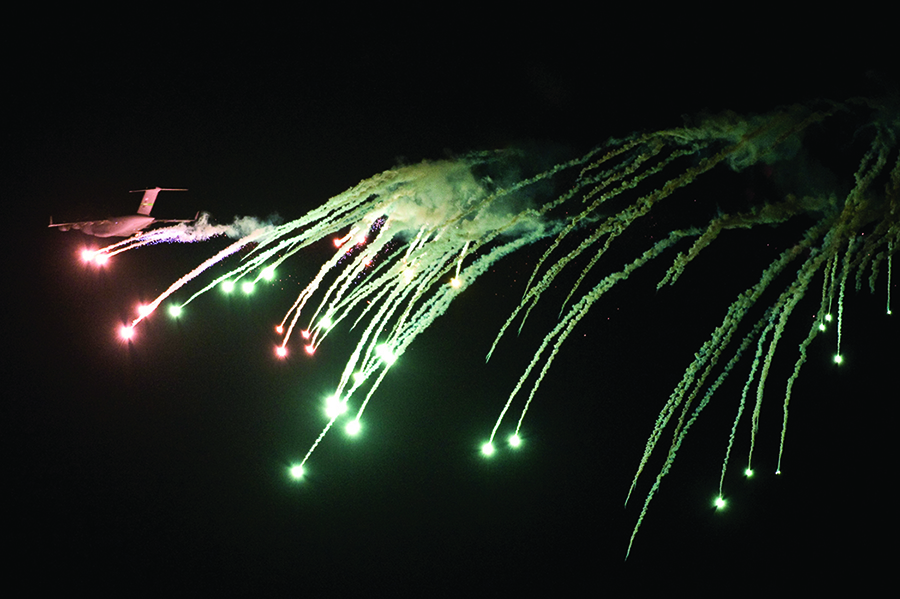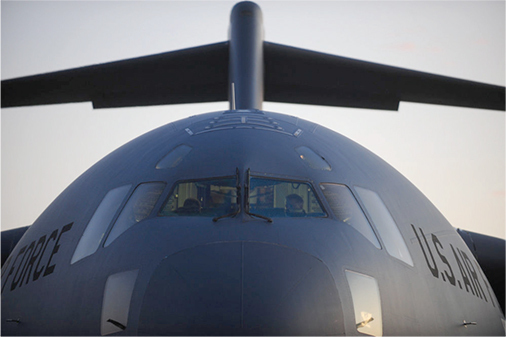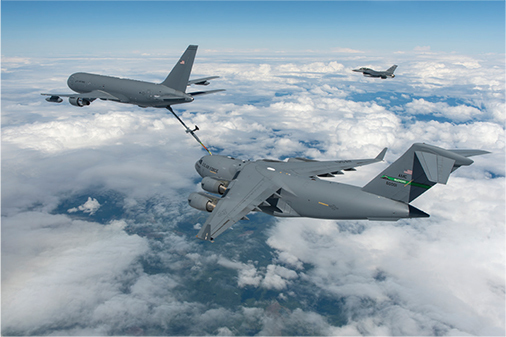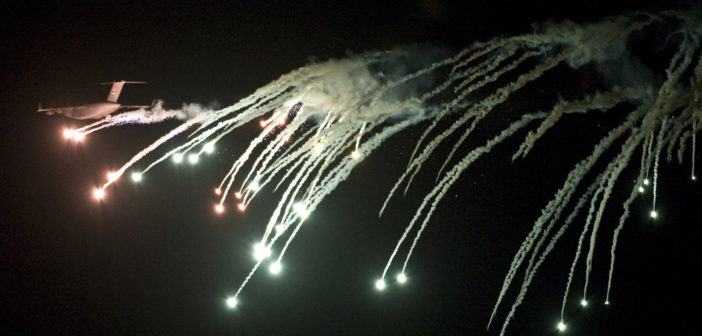
In February 2022, just hours into Russia’s invasion of Ukraine, Ukrainian forces shot down one, possibly two, Russian Il-76 (NATO name, CANDID) transport aircraft south of Kyiv. The aircraft were reportedly carrying paratroopers trained to take and secure airfields, and they were a critical piece of Russian plans to capture Kyiv in the early days of the conflict. Ukraine has claimed the aircraft (similar in size to US C-17) were brought down by its Air Defense Forces. The specific type of air-defense system responsible is unclear (from unclassified sources), with the possibility of it being a short-range defense weapon, but Ukraine is known to have brought down a number of other military aircraft with its Russian-made, long-range S-300 surface-to-air-missile systems. The provision of detailed US intelligence in advance of the raid is also reported to have played a significant role in the successful shoot-down. According to Air Force Technology, the Il-76 is equipped with a defensive aids suite, comprising radar warning, jammers, IR flare cartridges and chaff dispenser.
The dire significance of this event has not been lost on U. military planners. In fact, the emergence of longer-range, more sophisticated threats such as the Russian S-300 and S-400 air defense systems, together with changing mission requirements for large fixed-wing military aircraft to operate closer to, and even within, major threat environments has necessarily identified an immediate and pressing need to provide these aircraft (such as C-130, and C-17 transports, and KC-135 and KC-46 tankers), with improved and multi-spectral-threat electromagnetic protection systems. In its 2022 Command Strategy document, US Air Mobility Command’s, Gen Michael Minihan, USAF, stated that, “We must focus our energy to aggressively and urgently close gaps across four mission imperatives of Global Command, Control, and Communications, Navigation, Enroute under Attack (emphasis added), and the Tempo needed to win.”
Also, in a recent “From the Crows Nest” podcast, AOC’s Ken Miller spoke with retired USAF Colonel Jeff Fischer, who observed from his research on large aircraft operating in the Ukraine battlespace, that it’s a very different environment from what the US experienced in the Iraq and Afghanistan conflicts and, without EMS superiority as well as air superiority, the air defense systems of both Ukraine and Russia mean that air power (especially airlift) has not been much of a factor. “What you don’t see in Ukraine is heavy-lift, like C-17s and C-130s, resupplying forward lines. The reason for this is that without the ability to do electromagnetic warfare (EW) and take out missile systems, such as the S-300 and S-400, and have air superiority in conjunction with EW, you have a contested airspace and you’re not able to bring them in.” He points out that, “this would be a big problem for the way that NATO (especially US) brings people and equipment into a war zone.”
The point is further emphasized by Michael Baladjanian, Director of Self-Protect Systems at Raytheon Intelligence & Space (Arlington, VA). “The current threat environment we’re seeing contains the most sophisticated mouse traps we’ve encountered due to adversaries’ continued investments in science and technology. Detection abilities, density of sensor networks, communication resiliency, cyber sophistication, and weapon types and weapon speeds have complicated the mission for large aircraft. Ensuring uninterrupted supply to our Joint Services and allies is critical to the execution of domestic and international policies. The geopolitical landscape has shifted this century, and the US and its allies are now challenged in geographical locations and warfighting domains that were previously unopposed. We must continue to improve both our systems and tactics, techniques, and procedures (TTP), to prevail.”
James Conroy, Northrop Grumman (Rolling Meadows, IL), Vice President Electronic Warfare and Targeting agrees. “The threat environments have really changed and have been advancing. Where we were in the past, was really a situation where aircrews could use and leverage tactics and maneuvers to ensure survivability, but today the threat environment has evolved to the point where maneuvers and tactics and pre-canned planning unto themselves can’t ensure survivability. As a result, we’re seeing a lot of our large-aircraft users moving EW into the forefront of mind, looking at how they can have the ability to do detection, identification, tracking and jamming on platform.”
Mike Roske, BAE Systems’ (Nashua, NH) Technology Director, Electronic Combat Solutions, emphasizes another emerging facet of the threat. “Something that has very much changed in recent times is that the fight has shifted from a fight against an individual air-defense system to a fight against an entire network of participants. In the current hostile environment that large aircraft will be operating in, the guy that sees you is probably not the guy that is shooting at you. Shots can be taken from an extremely long range these days, and large aircraft may not know which direction it’s coming from. It may not even come from the same direction that you’re getting a radar detection from and are protecting against. This is only going to get worse over the next five, 10, 20 years and it’s critical to understand and address the implications.”
COUNTERING THE IR THREAT
The types of threats facing large fixed-wing aircraft are many and varied, but ever since the emergence of Man-Portable Air Defense Systems (MANPADS), IR-guided missiles have posed a particularly dangerous and prolific threat. That threat remains today, and with new, sophisticated technology constantly being deployed, it continues to grow.
To deal with the IR threat, the Services have developed, and widely-deployed, IR detection and countermeasure systems on its large-aircraft fleets. In particular, Northrop Grumman’s AN/AAQ-24 Large Aircraft IR Countermeasures (LAIRCM/DoN LAIRCM) system is currently deployed on C-17A, C-130H/J, C-5M, HC/MC-130J, KC-46A, KC-135, KC-130J, P-8A, and C-37B and C-40A/B/C fixed-wing aircraft, in addition to a large number of rotary-wing platforms. LAIRCM detects an incoming missile’s IR seeker and automatically jams it with a directed laser beam.
In March, a pod-contained version of the LAIRCM system achieved milestone C for the USAF’s KC-135 “Stratotanker” aircraft signaling the beginning of production and deployment. Says Neel, “The podded (LAIRCM G3) system is an easy way for us to put the capability on different aircraft without requiring a lot of A-kit modifications. It also allows for more flexibility with the platform depending on what environment it goes into.” The system is now in its second round of Low-Rate Initial Production.
Dennis Neel, Northrup Grumman Director of Advanced Survivability Programs, says “We’ve seen a lot of change over the more than thirty years we’ve been involved with IRCM. Even as IR countermeasure systems are deployed on more and more large-aircraft platforms, we recognize that the IR threat environment is constantly evolving and expect that to continue into the future. As the threat evolves, there will likewise continue to be a need for improved detection and countermeasure technologies, such as new IR and UV sensors, and improved lasers to combat [IR missiles] as well as assisting in situational awareness for the aircraft.” In May, the US Air Force Life Cycle Management Center (Wright-Patterson AFB, OH) awarded a $31.2 million contract to Northrop Grumman for new Advanced Threat Warning (ATW) sensors for the LAIRCM system.

RF WARNING SYSTEMS
While much attention has been focused on IR countermeasures for large aircraft over the past two decades, longer-range RF-guided threats have continued to evolve, as well. The danger has dramatically grown in recent years, as the range of these systems has expanded, and the requirement for transport, support, and special-mission large aircraft to operate near, or actually within, high threat environments has grown.
Says Northrop Grumman’s Conroy, “During the Global War on Terrorism (GWOT), the threat to our larger transport aircraft operating in hostile areas was primarily driven by short-range, IR-guided missiles from man-portable weapons systems. But, as we’ve transitioned from the GWOT to the current need to prepare for near-peer and peer-to-peer conflicts, the threat to our large-aircraft fleets from RF-guided systems has increased dramatically. Our large aircraft must be able to operate in environments that are much more complex and integrated and which can detect and engage our them at much longer range.”
This point is emphasized in the 2022 Air National Guard (ANG) Weapons Systems Modernization Priorities Book, which states that, “In accordance with National Defense Strategy defined competitors, mission modernizations must ensure overmatch including, but not limited to: radio frequency (RF), infrared (IR) self-protection systems, expendables, jammers, and signals intelligence/electronic intelligence detection capability and data.” The Priorities Book notes, in particular, that even in the course of routine operations, the ANG’s KC-135 tanker aircraft are increasingly subjected to hostile environments. “To survive, KC-135s require a digital radar warning receiver (RWR) capable of processing signals in a dense RF environment and automatically direct countermeasures to degrade or defeat RF threats.”
Given the vast number of platforms, generations, missions and users of large aircraft such as the C-130, C-17, KC-135, KC-46 etc., there have also been, and still are, a large number of different radar warning receivers (RWRs) being employed, even within the US fleet.
Among these are the Raytheon ALR-69A all-digital RWR which has been installed on C-130H aircraft. In 2018, the US Air Force awarded Raytheon an IDIQ to outfit their fleet of tactical air and large body aircraft with the ALR-69A. Since that award, ALR-69A has gone through significant enhancements, including frequency extensions that detect and identify RF threats across the spectrum.
In September 2019, Raytheon announced that it was delivering the next batch of ALR-69A radar warning receivers for USAF KC-46A “Pegasus” aerial refueling and transport aircraft. Says Baladjanian, “After the Air Force Association Air Space Cyber conference in September, the AMC’s KC-46A cross functional team lead, Brig Gen Ryan Samuelson stated, ‘The KC-46 now officially joins the rest of the Air Force’s refueling fleet in meeting combatant command requirements around the world.’” In total, Raytheon is providing 111 ALR-69A systems, including spares, to outfit its newest tanker. The contract calls for deliveries to be completed by 2025.
The Air Force’s latest-generation C-130J “Super Hercules” aircraft are equipped with BAE Systems’ AN/ALR-56M RWR. The digital RWR is a superheterodyne receiver operating in the 2GHz to 20GHz bands. It includes a low-band antenna and four high-band quadrant antennas. According to Roske, “We’ve had good success in the past with our ALR-56 series of programs, getting those involved in various places. The ALR-56 has a proven record on tactical aircraft and has been offered up for some of the large aircraft platforms, as well, as we look at modernization and bringing some of their EW suites up to date. Although integration is very different for different platforms, given the right suite of receive apertures and power amplifiers, the ALR-56M’s core EW processing is highly effective in various places.”
In March 2019, the US Army awarded Northrop Grumman a contract for the development of the latest iteration of its AN/APR-39 RWR system. In wide use on the Army’s fleet of rotary-wing aircraft, as well as Marine Corps KC-130 tankers, the AN/APR-39E(V)2, was formerly known as the Modernized Radar Warning Receiver (MRWR). According to the company, “it is intended to provide high-precision detection, location and identification using a Digital Receiver Exciter (DRE) and innovative signal processing algorithms.” The new warning system is expected to be able to see millimeter wave radars at longer ranges. Initial Operational Capability (IOC) is planned for 2025.
Also, on Air Force C130J aircraft is Northrop Grumman’s AN/AAR-47 missile warning system intended to protect the aircraft against IR-guided missile threats, laser-guided/laser-aided threats, and unguided munitions. It uses electro-optic sensors to detect missile exhaust and advanced signal processing algorithms and spectral selection to analyze and prioritize threats. Sensors are mounted near the nose just below the second cockpit window and in the tail cone. Upon detection of a missile threat, the system will automatically cue the AN/ALE-47 countermeasure system, which is capable of dispensing chaff and flares, as well as expendable active decoys.
ACTIVE JAMMING RF COUNTERMEASURE (RFCM) SYSTEMS
Although many large fixed-wing aircraft have been, or soon will be, equipped with radar warning receivers, the same is not true for RF countermeasures systems. Those that do carry the capability are large non-stealthy bombers and special-mission aircraft that must enter and persist in high-threat environments. These aircraft have been equipped with RF jammers for some time. For example, the L3Harris AN/ALQ-172 self-protection integrated RF subsystem has been in service on USAF B-52H bombers for decades, but the system has also been installed on Special Operations Command (SOCOM) MC-130H “Combat Talon II” and AC-130U gunships. According to L3Harris, the system can simultaneously counter multiple pulse, continuous wave, pulse Doppler and monopulse threats. The ALQ-172(V)3 upgrade provides for extended frequency coverage, and the company is now in development of the next system upgrade. “The ALQ-172 ‘MARS’ upgrade reduces system weight and power requirements while further improving system performance, maintainability, and reliability through the use of Field Programmable Gate Array (FPGA)-based technology.”
Meanwhile, SOCOM is replacing its MC-130H aircraft with the MC-130J, and in March of this year, Northrop Grumman delivered its first AN/ALQ-251 RFCM system for the Command’s AC-130J “Ghostrider” and MC-130J “Commando II” aircraft. According to the company, the ALQ-251 provides “situational awareness and 360-degree protection against EW systems and radar-guided weapons in contested and congested electromagnetic spectrum environments.” Sierra Nevada Corporation (Sparks, NV) is the integrator for the program.
As described by Conroy, “the ALQ-251 architecture uses a modular, open systems approach and common building blocks shared across other EW programs of record. This allows for more rapid updates and affordability throughout the lifecycle.” The ALQ-251 includes an integrated radar warning capability derived from the company’s APR-39 RWR family, and Conroy says “it also has the ability to interface with another onboard RWR, if desired, for a particular mission application.”
“RWR compatibility is a critical part on an RFCM system,” says Conroy. “You want to be able to detect threats while you’re also jamming them. Having an integrated RWR system really has a lot of benefits associated with it. With separate systems, there’s a lot of interfacing work that has to be done which is inherent within an integrated system. And, it’s not only compatibility associated with detection, identification and jamming, it’s also compatibility with all of the other systems on the platform.” For example, points out Conroy, “Although it’s not something AC/MC is specifically doing right now, if there was an AESA (radar) system on the platform, then you would necessarily need more interfacing. We recently demonstrated our ability to do that with one of our other systems the ALQ-257 (for the F-16). Because we have the AESA there and trying to be lethal with it, having a compatible RF EW system that interfaces with it, allows you to be lethal and survivable simultaneously.”
Conroy says SOCOM’s first modified platform with the ALQ-251 system installed has gone through initial testing and is about to start Developmental Test and Evaluation (DT&E) activities. “Concurrent with this, we’re also on contract for delivery of Low Rate Initial Production (LRIP) units this fall.”
While special operations large aircraft have been, and continue to be, protected with RF jamming countermeasure systems, questions still remain regarding the much larger fleets of Air Mobility Command’s (AMC’s) C-130 and C-17 aircraft. In that regard, Conroy notes that, in addition to protecting the AC/MC-130Js, the -251 system is applicable to the broader C-130 fleet as well. “Obviously, we see this as our large aircraft architecture, and we built the system in a very modular fashion to allow it the maximum amount of adaptability and extensibility to different large platform types. There are a number of potential users interested in the system, and we are in conversations with them.” Conroy says he can’t comment at this time on AMC’s specific plans, but does note, “They’re still maintaining some decisions on how they want to proceed in addressing the RF threat environment, but when the need for this capability arises, we would see the -251 as being a very strong contender to support them.”
The US Navy has also become increasingly aware of the need for RF countermeasures for its large-aircraft platforms, and BAE Systems has been working on a “quick-turnaround” effort for the Navy to add an RFCM capability to the P-8A Poseidon maritime-patrol aircraft. The system being evaluated is a lightweight pod mounted to the aircraft consisting of a small form factor jammer, a high-power amplifier and the AN/ALE-55 Fiber-Optic Towed Decoy (FOTD). According to BAE’s Roske, they’ve been doing a lot of work on the system through their Cyber and Electromagnetic Activities (CEMA) integration organization. “We’re working with various jammers that can be deployed on the platform with some very good success in terms of flight testing and demonstrating capabilities in our small form factor programs. It may seem odd to put small form factor items on some of these large platforms, but sometimes those are the nooks and crannies that you can put things into.”
BAE’s CEMA has also been closely involved with the AN/ALE-55 FOTD work. Says Roske, “Getting a towed decoy to work and to fly in a stable fashion is a difficult space, but we’ve been able to demonstrate excellent performance with the ALE-55.” Roske also notes with regard to integration with existing RWR systems on platforms, “What we’ve done in the past, and on many of the platforms we work with, was create federated interfaces between the RWR and jammer. The downside of this arrangement, however, is that information is passed back and forth at slower time scales, and where it starts to collapse is when you get into modern threats that require much faster jamming responses. You don’t have time for that kind of response timescale.”

MULTI-SPECTRAL THREATS, ARTIFICIAL INTELLIGENCE, AND THE TOTAL THREAT PICTURE
With both an increasing mix and growing sophistication of threats, single-spectrum detection and countermeasure systems have become inadequate for the large-aircraft protection task. Says Northrop Grumman’s Neel, “Today, our large-aircraft platforms require advanced, integrated, multispectral survivability systems to execute their missions with IR and RF capabilities really needing to work more collaboratively on the platform.”
In addition, says Conroy, “We should expect future adversary weapon systems will be better integrated, utilize more complex waveforms, and incorporate dynamic behavior guided by artificial intelligence and machine learning (AI/ML) to make them harder to detect and counter. To deal with these threat systems, our large aircraft platforms will need to fuse information from multi-domain, multi-spectral sensors and effectors. By combining multispectral capabilities together with AI, we’ll be able to not only more quickly engage these threats and assess what countermeasures to bring to bear to protect own aircraft, but also look at solutions that more holistically help to protect an entire group of aircraft.”
Roske says BAE is also focused on this requirement. “I work closely with my counterparts in the IR domain and the battle-management and sensor-fusion domains to make sure that we have the right processing allocated into each of those segments, such that we can indeed create an integrated, common operating picture across a fully-distributed battle management suite with AI and cognitive-EW algorithms in the right spaces.”

NETWORKED DATA SOURCES AND THREAT-RESPONSE TIMELINES
In addition to their susceptibility to MANPAD weapons, large-aircraft platforms are also particularly vulnerable to long-range threats. One reason for this is simply that they are in fact large and present considerable radar cross sections. As BAE’s Roske pointed out, “Because large platforms are relatively easy to detect in the first place, the threat can really come from anywhere, with possible responses ranging from vectoring a defensive counter-air patrol toward you to the use of surface-to-air missiles along the way.” But the good news he says is, “no-one is flying alone, so each aircraft can work as part of its own network and battle management suite, as well as work across the full spectrum (RF, IR, optical) to make sure that the right assets are working at the right places at the right times.”
Roske says, one way to accomplish is to look at and evaluate the activity across an adversary’s own networks. “You want to make sure that you’re monitoring and understanding changes in those networks’ behavior and, if you see some increased activity someplace, that is probably an area that you want to play closer attention to. For example, if there’s an indication of a detection, take a look at the waveforms to get an understanding of what that radar thinks of you, and draw some conclusions as to whether or not you are detectable and what you should be looking out for.”
Northrop Grumman’s Conroy agrees, noting that he “can easily envision the day when we have to transcend single-ship survivability to multi-ship survivability. That multi-ship survivability is obviously going to require interfacing over a network structure such as Joint All Domain Command and Control (JADC2) to really share data between platforms to be successful.” This is something Conroy says his company is provisioning for in a number of their products – “to enable the sharing of data but also, as the platforms receive data, they are actually elevating and leveraging that data as well.” As an adjunct to this, he adds that “what’s going to be critical for some of those things is not only knowing where each of those multi-ship platforms are residing, but also the timing of the data or data latency associated with it.”
Neel adds that, “besides making sure that you’re connected into networks that allow you to understand the total threat environment, you need to ensure that the timelines needed to provide protective actions are adequate.” He emphasizes that, “countermeasure are all about timelines. You need enough time to defeat the threat which means you first have to find it, and the sooner you know there’s a threat out there, even if you can’t see a launch, it’s important to get that information quickly.” Neel references a recent demonstration of such capabilities at the AUSA Annual Meeting. “We have a program that is actually looking at doing flight planning and having that flight planning be more dynamic, where threat warning, or potential threat warning information, comes not only from the platform itself and from other platforms, but also from mission planners and other sources. Then, you’ll know about that threat with enough time to dynamically change the mission plan for the platform. These are the types of things that will allow for a robust enough timeline to be able to defeat the threat.”
Raytheon’s Baladjanian also sees the criticality of networked threat warning and rapid response times, pointing out that the US Air Force is working toward a way for all assets to be able to share their information in real-time. “Defending our High Value Airborne Assets (HVAA), such as AWACS, Rivet Joint, JSTARS and Compass Call, has become so important that the loss of even one could seriously impact US warfighting capabilities or provide the enemy with significant propaganda value.”
MODULARITY AND OPEN ARCHITECTURES
Another key element to successfully bringing capable, agile, and affordable self-protection systems to large-aircraft fleets is the adoption and implementation of open architecture designs and standard interfaces.
Baladjanian says Raytheon has definitely embraced DOD’s shift to open-standard architectures. “We’ve shown this capability in various demonstrations, which enables a faster innovation cycle at lower cost. Future self-protect systems must be designed to ensure scalability, adaptability, agility and affordability, while delivering critical capabilities.”
Northrop Grumman is also on board. Says Neel, “We’re not only looking at open architectures and modularity in terms of what we can do to evolve system capabilities along with the threat, but also what we can do on the platforms – new and existing – to evolve with the mission of the platform, as well as the threat. It used to be that the systems put on platforms only had to work with the installed system, but now they have to actually interact with the rest of the platform, and that means you have to have open architectures that allow for rapid development and upgrades. Open architectures and standards, like the Future Airborne Capability Environment (FACE) and Modular Open Systems Approach (MOSA), will allow us to continue to evolve and connect more of the systems on the platform and provide operators with a more holistic picture of the environment that their flying through. Our adversaries are not slowing down with their changes, and we need to be able to keep up with those threats. This is the way to do that.”
Conroy adds that open architectures and standards also “enable best-off-breed capabilities to be implemented on platforms. We not only have open architectures within our systems, but we also leverage a lot of commonality between different systems such that we can take in and leverage the investments made across multiple customer communities.”

NEXT-GENERATION TECHNOLOGY
Of course, regardless of what level of technology is available and being deployed today for large-aircraft self-protection, the future will demand more and better. This is why EW companies are constantly looking forward to anticipate the future threat environment. At Northrop Grumman, Neel says, “We’re always looking at different things that we can do, such as upgrading lasers and improving multi-spectral sensors with larger focal plane arrays together with advanced software architectures.”
For his part, Conroy says it’s important to recognize that, in future, the threat will not be limited to systems exploiting individual parts of the EMS working independently, but will be multi-spectral threats collecting and correlating data for greater effect. “We’ll have to likewise be able to accord appropriate responses to those advanced threats,” he says, pointing out that they’re doing a lot of advanced science and technology (S&T) work to ensure that large-aircraft self-protection systems are “not only able to automatically detect, track and jam threats, but also provide situational awareness up to the flight deck so they have all the information they need to make informed decisions on how to execute their missions.”
Going forward, he foresees the evolution of the RF EW space shifting from a very hardware-focused to a hardware-enabled, software-defined capability. “Systems are going to need to be very agile – able to sense the environment and make some reasoning as to how they will respond. New types of machine-learning or AI software algorithms will have to come into play at some point in time. In the near-term, it will be more like rationalization or statistical processing – more Boolean-Logic-based or clear yes/no answers, but later it will involve evaluating what kind of confidence you have in those answers. That will be the stepping stone from where we are today to the future goal of re-writing source code on the fly.”
In addition, however, Conroy says that together with looking at new and emerging technologies, they also have to continue to emphasize design priorities, such as reducing SWaP-C. “Adding capability always requires a balance between what needs to be accomplished in order to address future threats while still enabling the warfighters to meet mission requirements and, as the threat environment continues to evolve, we have to keep very abreast of that. For the larger platforms, and for multi-ship protection, this means you also have to consider some of the off-boarding capability options available through very small SWAP-C suppression of enemy air defense (SEAD) technology. You have to be able to pair high-value assets with low-value assets that won’t be coming back at the end of the day.”
At BAE, Roske says they’re looking into the future with a recognition that “the days are gone when you had to go get new hardware to bring something new to the fight. Today, the fight is constantly and rapidly changing, and that approach isn’t going to work.” Instead, he says their focus is on convergence and open-architecture solutions. “This allows us to have a high-rate production line that provides some commonality of both reprogrammable hardware, supports third-party insertions, and can bring new capabilities to the fight on a regular basis. Some of these architectural standards are still in their infancy, but it’s the right answer for the warfighter to be able to support items that do indeed work together across industry and across government and military development.”
One example of BAE’s work in this area is the company’s recently-introduced Storm EW™ Modules aimed at accelerating the delivery of software-based EW capabilities through a common-core architecture. Their scalable design provides a hardware baseline that can be customized and integrated into multiple airborne platforms to reduce engineering and lifecycle costs.
Says Roske, “These are highly-capable systems that provide the ability to detect and respond at the speed-of-the-fight, which is one of the most important things to consider as you’re building an EW suite. There are some things that you can take more time to digest and understand, but when push comes to shove, speed is life, and it’s critical to get your electronic responses out at the right – and very fast – times to defeat the threat.”
Another focus area at BAE, says Roske, is looking at “where we go with cognitive EW and information fusion, and how do we learn from the battlespace while we’re in the fight, from fight to fight, and from day to day, to make sure that we’re using all of the assets in the environment for what their purpose is, as well as fusing common information.” In pursuit of this, Roske says they’re approaching the challenge from a perspective that “doesn’t just look at EW as something you have to have to protect yourself while you do your real mission, but rather looks at EW as the real mission and using the spectrum to help spoil the enemy’s day.”
As with many EW mission areas, the way we protect large aircraft is entering a new era. After decades of focusing almost exclusively on self-protection strategies, large aircraft survivability in the future will depend on many offboard resources that provide situational awareness, dynamic mission planning, support jamming and even fighter escorts. As threat technology continues to evolve, major EW systems houses are focused on developing survivability solutions that can be fielded ahead of those threats.





